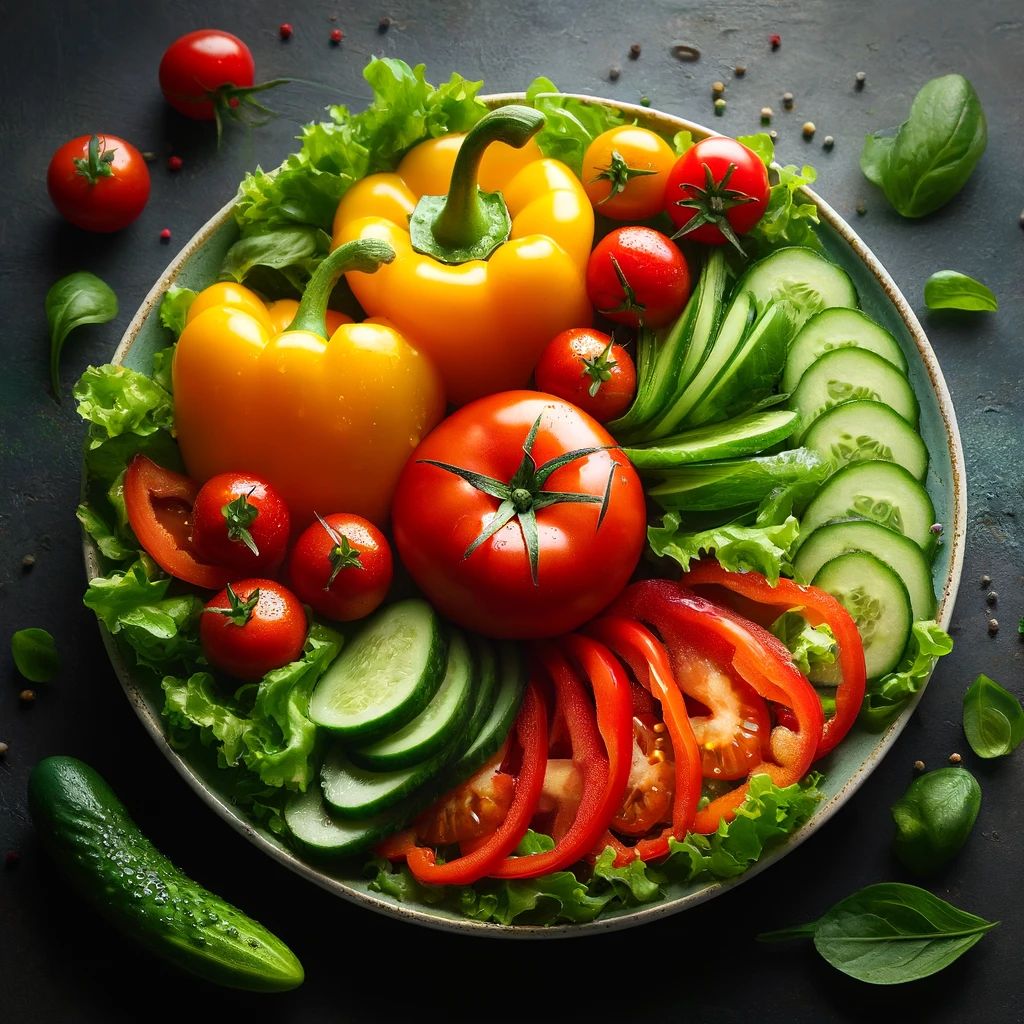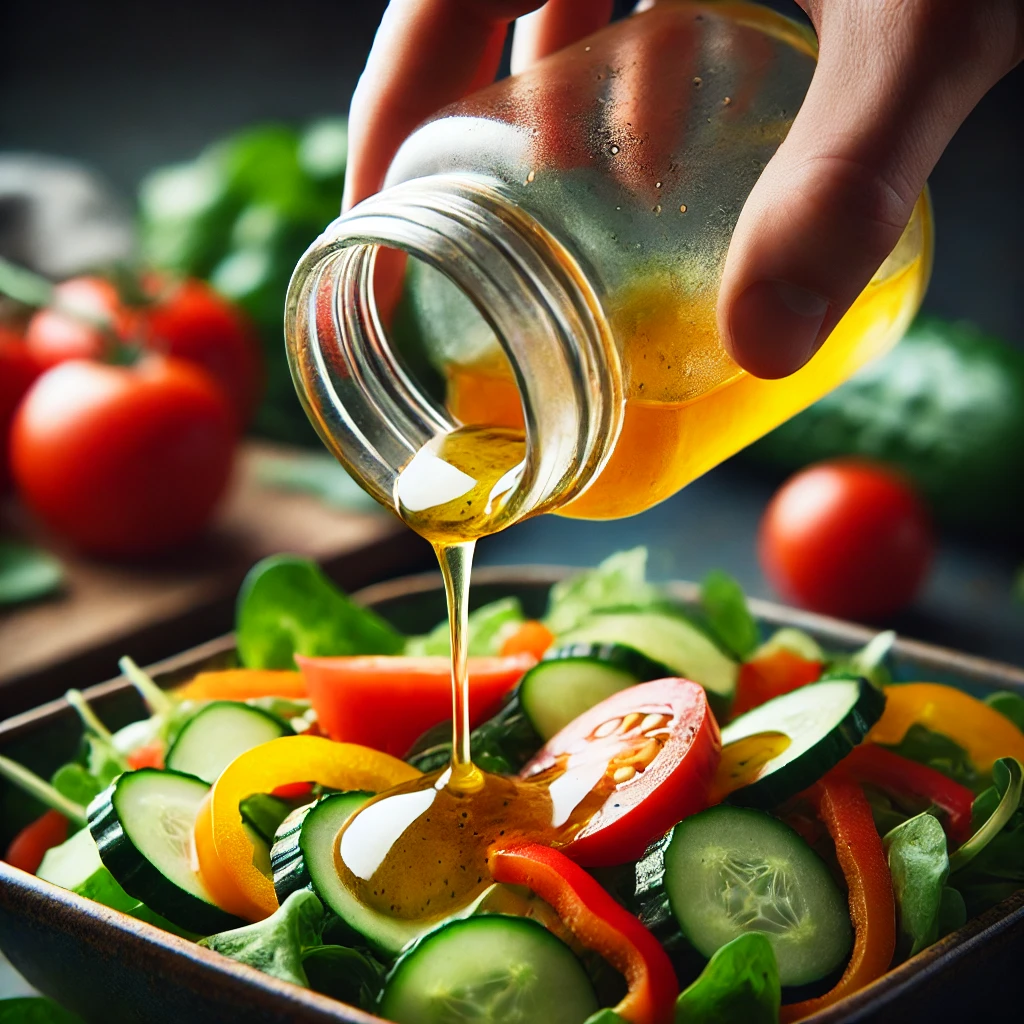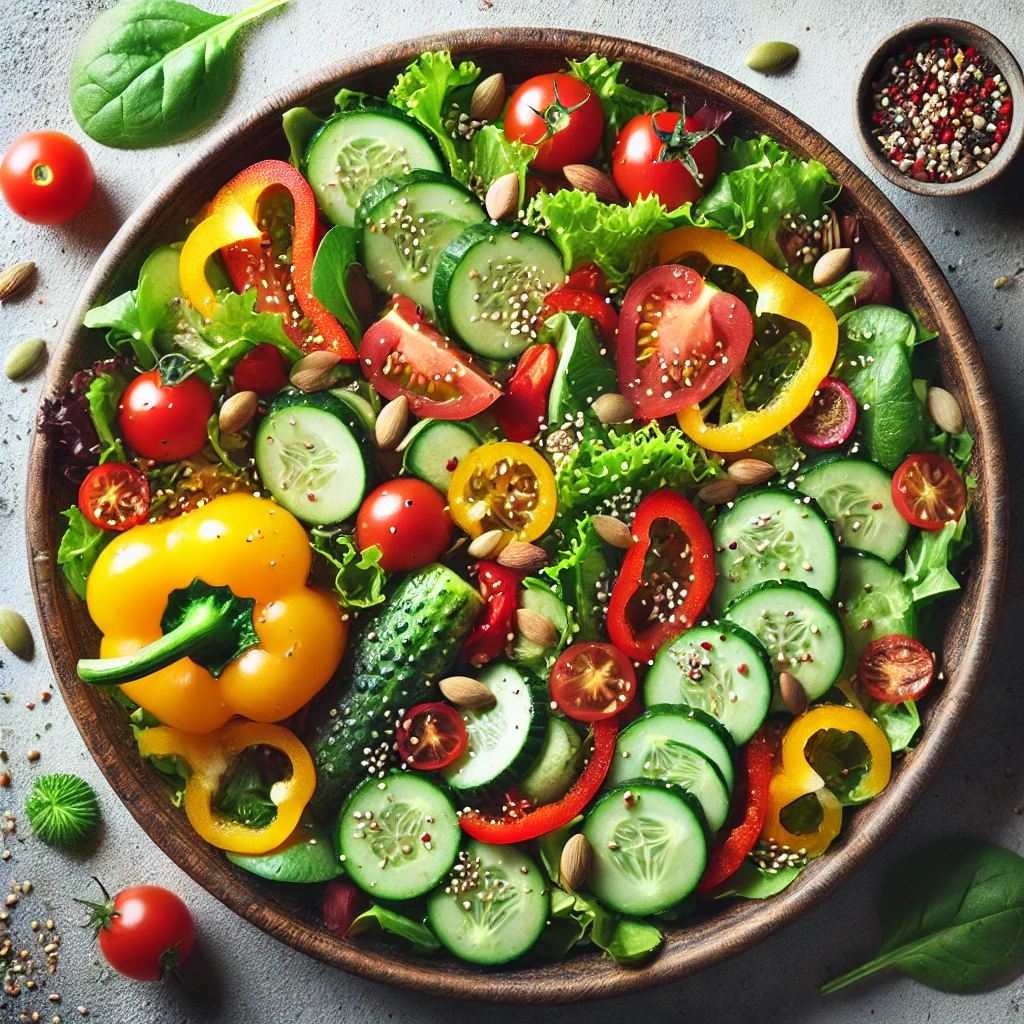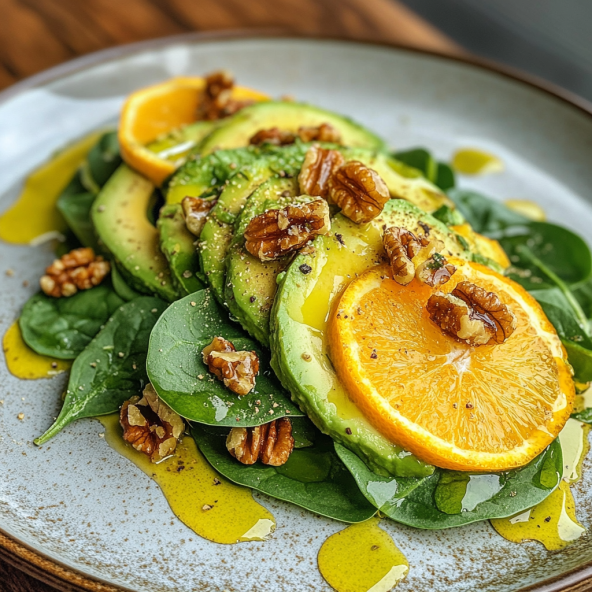If you’ve ever wondered how culinary creations can be influenced by fine art, this post is for you. In this blog, we’ll explore how a Green Leaf Salad Inspired by the Art can go beyond just a meal, becoming a true work of edible art. From the thoughtful selection of ingredients to the creative use of culinary techniques and artistic presentation, we’ll show you how food and art come together to create a sensory masterpiece on the plate. Whether you’re a chef or a home cook, get ready to be inspired by how flavor, texture, and color can make your salad a stunning work of art.https://mymealrecipes.com/the-painting-of-the-plate-green-leaf-salad-inspired-by-the-art-of-henri-matisse/
The Ingredients: Nature’s Palette in Green Leaf Salad
When creating a Green Leaf Salad Inspired by the Art, the ingredients are more than just food—they serve as the “paint” on your culinary canvas. Selecting fresh, vibrant, and nutrient-rich components is key to bringing your dish to life, both in flavor and presentation.
Greens: The Foundation of Your Canvas
The base of your salad sets the stage for the rest of the ingredients, much like a blank canvas for an artist. For a Green Leaf Salad, you can choose from a variety of leafy greens, each with its own texture, color, and taste profile. Consider options like:
- Spinach: Rich in nutrients, with a slightly sweet flavor and vibrant green hue.
- Arugula: Known for its peppery taste, this adds a bold contrast to the salad.
- Kale: A hearty and earthy green that adds texture and depth.
- Romaine: Crisp and refreshing, this green adds a light, neutral flavor that complements other bold ingredients.

Colorful Vegetables: Adding the Artistic Touch
Just as an artist chooses their colors wisely, adding vibrant vegetables to your Green Leaf Salad Inspired by the Art brings the dish to life. These ingredients can mirror the vibrancy of an artist’s palette:
- Cherry Tomatoes: Bright red pops of color, juicy, and slightly sweet.
- Bell Peppers: Available in a variety of shades—red, yellow, or orange—these add a sweet crunch.
- Carrots: Thinly sliced or shredded, carrots bring a bold orange hue and a hint of sweetness.
- Cucumbers: Offering a cool, refreshing crunch, cucumbers add a lighter green to the palette.

Herbs: The Finishing Strokes
Herbs like basil, parsley, and mint act as the final strokes of an artwork, adding aromatic notes and subtle flavors that elevate the entire salad. Use them sparingly but thoughtfully to enhance the overall taste.

Dressings: Blending Flavors Like Colors
The dressing brings all the ingredients together, much like how an artist blends colors on a palette. For a Green Leaf Salad Inspired by the Art, consider dressings that complement both the visuals and flavors:
- Vinaigrettes: A simple olive oil and balsamic vinegar combination adds a glossy sheen and enhances the flavors without overpowering the salad.
- Citrus Dressing: Bright and zesty, citrus-based dressings offer a splash of sunshine on your plate, visually and taste-wise.

By thoughtfully selecting your ingredients and focusing on vibrant colors, textures, and flavors, you’ll create a Green Leaf Salad Inspired by the Art that’s both a feast for the eyes and the palate. Each element plays its part, just as each brushstroke contributes to a masterpiece.
Presentation: Plating Inspired by Famous Art Movements
In the world of culinary art, plating is where food becomes a visual masterpiece, much like how painters use their canvases. For a Green Leaf Salad Inspired by the Art, the way you plate the dish can significantly enhance the dining experience. Drawing inspiration from famous art movements allows you to transform a simple salad into an eye-catching and memorable presentation.
Impressionism: Capturing Light and Color
Impressionist art is known for its focus on light, color, and emotion. When plating your Green Leaf Salad, you can evoke the spirit of this movement by layering ingredients in a way that mimics soft, blended strokes. Use vibrant greens and brightly colored vegetables to create depth and dimension. Rather than arranging the salad in a rigid, structured way, allow the ingredients to flow naturally across the plate, creating a sense of movement.

Abstract Art: Bold, Geometric Presentation
Inspired by abstract artists like Piet Mondrian, consider arranging your salad components in bold, geometric patterns. For a Green Leaf Salad Inspired by the Art, slice vegetables into clean lines and shapes, placing them strategically on the plate to create an artistic composition. This style of plating is perfect for showcasing a minimalist approach, where each element has its own space and significance.

Surrealism: Unexpected Elements and Playfulness
Surrealist artists like Salvador Dalí played with the unexpected and bizarre. You can bring this whimsical approach to your Green Leaf Salad by incorporating surprising elements or playing with proportions. For example, you could use edible flowers or unique shapes like spiralized vegetables to add an element of surprise. Additionally, mixing contrasting textures—such as crunchy greens with soft, roasted vegetables—creates a surreal, sensory experience.

Minimalism: Clean, Elegant Simplicity
Inspired by minimalist art, this approach focuses on fewer ingredients but with greater emphasis on each one. For a Green Leaf Salad Inspired by the Art, use only a few high-quality ingredients and arrange them neatly on a plain white plate. The clean simplicity of this style allows each color and texture to shine, creating an elegant, refined look.
Cubism: Fragmented and Layered Presentation
Cubism, led by artists like Picasso, focuses on breaking down objects into fragments and presenting them from multiple perspectives. You can plate your Green Leaf Salad in layers or in a fragmented manner, where different sections of the salad are placed on different parts of the plate, each representing a unique perspective. This creates a dynamic and multi-faceted presentation that challenges the traditional way of arranging food.

Flavor Pairing: An Artistic Balance of Taste and Texture
When crafting a Green Leaf Salad Inspired by the Art, flavor pairing becomes an essential part of the creation process. Just like an artist balances colors and shapes on a canvas, chefs must carefully combine flavors and textures to create harmony in a dish. The goal is to stimulate the palate in a way that evokes emotion, much like viewing a beautiful piece of art.
Balancing Sweet, Sour, and Savory Flavors
In a Green Leaf Salad Inspired by the Art, the interplay of flavors—sweet, sour, and savory—creates a balanced and memorable dish. Each ingredient should complement the other while contributing to the overall taste experience:
- Sweetness can come from ingredients like cherry tomatoes, apples, or dried fruits like cranberries. These add a burst of natural sugar that pairs well with the freshness of greens.
- Sour notes can be introduced through vinaigrettes made with lemon juice, balsamic vinegar, or other acidic dressings. The tartness helps to cut through richer ingredients like avocados or creamy cheeses.
- Savory elements often come from additions like roasted nuts, grilled chicken, or crumbled feta cheese. These provide depth and contrast to the lighter, fresher flavors of the greens and vegetables.

Texture: The Hidden Element of Flavor
Texture plays a crucial role in how we perceive flavors. By combining different textures in your Green Leaf Salad, you create a dynamic eating experience that keeps the diner engaged with each bite:
- Crunchy textures from toasted nuts, seeds, or croutons add excitement and a satisfying contrast to the softer ingredients.
- Creamy elements like avocado or goat cheese create a rich, smooth texture that balances the crunch.
- Crisp vegetables such as cucumbers, radishes, and peppers provide a refreshing bite that keeps the salad light and enjoyable.
Using Color to Influence Flavor Perception
Just like color theory in painting, the colors on your plate can influence how flavors are perceived. In a Green Leaf Salad Inspired by the Art, bright, bold colors can signal freshness and flavor:
- Green tones from spinach or kale suggest health and vitality, while their fresh, mild flavors act as a neutral base for stronger ingredients.
- Red and orange hues from bell peppers and cherry tomatoes bring sweetness and visual vibrancy, enhancing the appeal of the salad.
- White or pale elements, like feta cheese or sliced almonds, provide contrast and complement the stronger colors, while their mild flavors balance the bolder ingredients.

Pairing Ingredients for a Memorable Salad
In a Green Leaf Salad Inspired by the Art, certain ingredients naturally pair well together, creating a perfect balance of taste and texture. Consider combinations like:
- Spinach, strawberries, and walnuts: The mild bitterness of spinach pairs beautifully with the sweet strawberries, while the walnuts add a satisfying crunch.
- Arugula, goat cheese, and roasted beets: The peppery arugula contrasts with the creamy goat cheese, and the earthy, sweet beets complete the trio with a rich texture.
- Kale, avocado, and sunflower seeds: The hearty kale serves as a perfect foundation for the creamy avocado, while sunflower seeds add a touch of crunch and a nutty flavor.

By carefully balancing flavors and textures, your Green Leaf Salad Inspired by the Art becomes more than just a meal—it becomes an experience that pleases the senses and tells a story through taste.
Culinary Techniques: Crafting the Artful Green Leaf Salad
When creating a Green Leaf Salad Inspired by the Art, culinary techniques play a crucial role in transforming simple ingredients into a visually stunning and flavorful dish. Just like an artist uses specific brushstrokes to craft a masterpiece, chefs and home cooks alike can use various techniques to elevate the salad and make it a work of culinary art. Here are some techniques to consider when crafting your artful salad.
Knife Skills: Precision in Preparation
Mastering basic knife skills is essential for creating clean, even cuts that enhance both the texture and visual appeal of your Green Leaf Salad Inspired by the Art. Slicing ingredients into thin, even shapes ensures uniformity, while more artistic cuts, like julienne or chiffonade, can add a creative flair:
- Julienne: Cutting vegetables like carrots or bell peppers into matchstick-sized pieces adds a crisp texture and eye-catching design.
- Chiffonade: This technique is used for leafy greens, like spinach or basil, where you roll the leaves tightly and slice them into thin ribbons. It adds elegance and an airy texture to the salad.

Blanching: Enhancing Color and Texture
Blanching is a technique where vegetables are briefly boiled and then plunged into ice water. This process locks in their vibrant color while maintaining their crisp texture. For a Green Leaf Salad Inspired by the Art, blanching can make your greens more vibrant and slightly more tender without losing their crunch:
- Asparagus, broccoli, and green beans are great candidates for blanching, as it enhances their color and softens them slightly while retaining their bite.

Roasting: Bringing Depth to the Salad
Roasting vegetables brings out their natural sweetness and adds depth of flavor to your salad. In a Green Leaf Salad, roasted ingredients such as butternut squash, carrots, or beets add warmth, color, and a slightly smoky flavor:
- Toss vegetables in olive oil, salt, and pepper, then roast at high heat to caramelize the edges, creating contrast in both flavor and texture.

Building Layers: Texture and Visual Appeal
When plating your Green Leaf Salad Inspired by the Art, think of each layer as a different dimension of flavor and texture. Start with the base of fresh greens, then build upwards with roasted vegetables, crunchy toppings, and finally, a drizzle of dressing to tie it all together. Layering allows the textures to interact:
- Crunchy elements like nuts or seeds should be placed on top, while creamy ingredients like avocado or cheese can be nestled in between the layers of greens.
- This technique gives depth to the dish and keeps it visually engaging with contrasting textures and colors.

Embracing Modern Techniques: Molecular Gastronomy
For those looking to take their Green Leaf Salad to the next level, modern techniques like molecular gastronomy can turn your dish into a true culinary spectacle. Techniques such as spherification, which transforms liquids into delicate, caviar-like pearls, can add an artistic and surprising element to your salad:
- Imagine adding balsamic vinegar pearls or olive oil spheres to your salad for an unexpected burst of flavor that mirrors the precision of an abstract painting.

By using these culinary techniques, your Green Leaf Salad Inspired by the Art can become an edible masterpiece. Each method, from precise knife skills to creative modern techniques, contributes to a salad that is both a visual and flavorful work of art.

Green Leaf Salad Inspired by the Art
Ingredients:
- 4 cups mixed leafy greens (spinach, arugula, kale)
- 1/2 cup cherry tomatoes, halved
- 1/2 cucumber, spiralized or thinly sliced
- 1/2 red bell pepper, thinly sliced
- 1/2 yellow bell pepper, thinly sliced
- 1/4 cup crumbled feta cheese
- 1 avocado, sliced
- 2 tablespoons balsamic pearls (optional, for an artistic touch)
- Edible flowers (optional, for decoration)
- 2 tablespoons roasted sunflower seeds or walnuts
For the Citrus Vinaigrette:
- 3 tablespoons olive oil
- 1 tablespoon freshly squeezed lemon juice
- 1 tablespoon balsamic vinegar
- 1 teaspoon Dijon mustard
- Salt and pepper to taste
Preparation Steps:
- Prepare the Greens: Lay the mixed leafy greens on a large salad plate, spreading them loosely to create an organic, flowing base, much like an Impressionist painting.
- Arrange the Vegetables: Artfully arrange the halved cherry tomatoes, spiralized cucumber, and sliced bell peppers on top of the greens. Aim for a vibrant and colorful display, creating a balance of texture and colors.
- Add the Feta and Avocado: Gently place the crumbled feta cheese and sliced avocado across the salad, maintaining the natural, abstract arrangement. These ingredients add creaminess to balance the crisp vegetables.
- Sprinkle Garnishes: If using balsamic pearls and edible flowers, scatter them over the salad for a whimsical, artistic touch. Add roasted sunflower seeds or walnuts for a crunchy texture.
- Make the Citrus Vinaigrette: In a small bowl, whisk together the olive oil, lemon juice, balsamic vinegar, and Dijon mustard. Season with salt and pepper to taste.
- Drizzle the Dressing: Lightly drizzle the citrus vinaigrette over the salad. For a more artistic presentation, drizzle in abstract swirls across the ingredients.
Preparation Time:
- 20 minutes
Difficulty:
- Easy
This salad reflects the theme of the article, combining artistic plating and balanced flavors to create a visually stunning, flavorful dish perfect for any meal.
Conclusion:
Creating a Green Leaf Salad Inspired by the Art is more than just a culinary task; it’s an opportunity to blend creativity, flavor, and visual appeal into one edible masterpiece. By thoughtfully selecting ingredients that represent the colors and textures of an artist’s palette, you can transform a simple salad into something truly extraordinary. Using culinary techniques like precision knife skills, roasting, blanching, and even molecular gastronomy, you elevate your salad to a new level of artistry.
From vibrant greens to carefully plated compositions, the process of making a Green Leaf Salad Inspired by the Art is all about balance—balancing flavors, textures, and visuals to create an engaging sensory experience. Whether you’re drawing from famous art movements or experimenting with modern techniques, this salad reflects how food and art can come together to inspire both the cook and the diner.
As you embrace the artistic potential in your own kitchen, remember that your creativity can transform a meal into more than just nourishment—it can become a canvas of flavors, textures, and colors. So next time you prepare a salad, approach it with the mindset of an artist, crafting a dish that tells a story through both taste and presentation.
For more inspiration and recipes like this, explore our blog and let your culinary imagination run wild! https://mymealrecipes.com/low-carb-breakfast-recipes/

